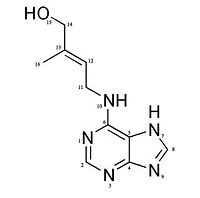Editing User:Pauline Hanns/Sandbox 1
From Proteopedia
(Difference between revisions)
| Line 42: | Line 42: | ||
===='''Substrate binding domain'''==== | ===='''Substrate binding domain'''==== | ||
| - | The substrate binds by following a '''“plug-into-socket”''' mode and this way of binding will cause no conformational change during binding at the active site in contrary to a lot of other dehydrogenases and oxidases. This binding mode will '''seal the active site'''. In order to have no need of movements the CKX enzyme shows a very good pre-organisation and complementary with the cytokinin substrate. There are three amino acids which play a key role in the enzyme activation: Asp169, Glu288 and Glu381. The Asp169 residue of the enzyme is '''Hydrogen-bonded to the N10 atom of the substrate''' (various studies have shown that it is involved in the '''recognition of the substrate''') and to the Glu288 residue. The Asp169-Glu288 pair implies that a '''proton is shared between the two side-chains'''. We can’t know the exact protonation state but the pair suppose Asp169 is an active-site base and possibly involved in proton abstraction from the substrate N10 atom. The substrate is also recognized by Glu381 which is '''Hydrogen-bonded to the N7 atom of the cytokinin'''. The others N-atoms are Hydrogen-bonded '''with the solvent except''' for N1 atom. The end of the substrate aromatic chain is located between the N10 atom of FAD, Leu492 and Asn399. These interactions allow the positioning the '''C11 atom of the cytokinin substrate''' very close to the '''flavin N5 atom''' (at about 3.0 Angström). Indeed it is this carbon atom which will be the site of the '''oxydative attack of the cytokinin by the FAD cofactor''' <ref name="Malitoa">PMID: 15321719 </ref> <ref name="Kopečnýa">PMID: 20478354 </ref> | + | The substrate binds by following a '''“plug-into-socket”''' mode and this way of binding will cause no conformational change during binding at the active site in contrary to a lot of other dehydrogenases and oxidases. This binding mode will '''seal the active site'''. In order to have no need of movements the CKX enzyme shows a very good pre-organisation and complementary with the cytokinin substrate. There are three amino acids which play a key role in the enzyme activation: <scene name='68/686754/Asp169_glu288_glu381/1'>Asp169, Glu288 and Glu381</scene>. The Asp169 residue of the enzyme is '''Hydrogen-bonded to the N10 atom of the substrate''' (various studies have shown that it is involved in the '''recognition of the substrate''') and to the Glu288 residue. The Asp169-Glu288 pair implies that a '''proton is shared between the two side-chains'''. We can’t know the exact protonation state but the pair suppose Asp169 is an active-site base and possibly involved in proton abstraction from the substrate N10 atom. The substrate is also recognized by Glu381 which is '''Hydrogen-bonded to the N7 atom of the cytokinin'''. The others N-atoms are Hydrogen-bonded '''with the solvent except''' for N1 atom. The end of the substrate aromatic chain is located between the N10 atom of FAD, Leu492 and Asn399. These interactions allow the positioning the '''C11 atom of the cytokinin substrate''' very close to the '''flavin N5 atom''' (at about 3.0 Angström). Indeed it is this carbon atom which will be the site of the '''oxydative attack of the cytokinin by the FAD cofactor''' <ref name="Malitoa">PMID: 15321719 </ref> <ref name="Kopečnýa">PMID: 20478354 </ref> |
=='''Mechanism'''== | =='''Mechanism'''== | ||
Revision as of 12:02, 9 January 2015
2qkn
Crystal structure of Maize cytokinin oxidase/dehydrogenase complexed with phenylurea inhibitor CPPU
| |||||||||||
References
- ↑ 1.0 1.1 1.2 1.3 1.4 Frebortova J, Novak O, Frebort I, Jorda R. Degradation of cytokinins by maize cytokinin dehydrogenase is mediated by free radicals generated by enzymatic oxidation of natural benzoxazinones. Plant J. 2010 Feb 1;61(3):467-81. doi: 10.1111/j.1365-313X.2009.04071.x. Epub, 2009 Nov 14. PMID:19912568 doi:http://dx.doi.org/10.1111/j.1365-313X.2009.04071.x
- ↑ 2.0 2.1 2.2 2.3 2.4 2.5 2.6 Kopecny D, Briozzo P, Popelkova H, Sebela M, Koncitikova R, Spichal L, Nisler J, Madzak C, Frebort I, Laloue M, Houba-Herin N. Phenyl- and benzylurea cytokinins as competitive inhibitors of cytokinin oxidase/dehydrogenase: a structural study. Biochimie. 2010 Aug;92(8):1052-62. Epub 2010 May 15. PMID:20478354 doi:10.1016/j.biochi.2010.05.006
- ↑ Kopecny D, Sebela M, Briozzo P, Spichal L, Houba-Herin N, Masek V, Joly N, Madzak C, Anzenbacher P, Laloue M. Mechanism-based inhibitors of cytokinin oxidase/dehydrogenase attack FAD cofactor. J Mol Biol. 2008 Jul 25;380(5):886-99. Epub 2008 May 24. PMID:18571199 doi:10.1016/j.jmb.2008.05.044
- ↑ 4.0 4.1 4.2 4.3 Kopecny D, Pethe C, Sebela M, Houba-Herin N, Madzak C, Majira A, Laloue M. High-level expression and characterization of Zea mays cytokinin oxidase/dehydrogenase in Yarrowia lipolytica. Biochimie. 2005 Nov;87(11):1011-22. PMID:15927342 doi:http://dx.doi.org/10.1016/j.biochi.2005.04.006
- ↑ 5.0 5.1 5.2 5.3 5.4 Malito E, Coda A, Bilyeu KD, Fraaije MW, Mattevi A. Structures of Michaelis and product complexes of plant cytokinin dehydrogenase: implications for flavoenzyme catalysis. J Mol Biol. 2004 Aug 27;341(5):1237-49. PMID:15321719 doi:http://dx.doi.org/10.1016/j.jmb.2004.06.083
- ↑ 6.0 6.1 Schmulling T, Werner T, Riefler M, Krupkova E, Bartrina y Manns I. Structure and function of cytokinin oxidase/dehydrogenase genes of maize, rice, Arabidopsis and other species. J Plant Res. 2003 Jun;116(3):241-52. Epub 2003 Apr 29. PMID:12721786 doi:http://dx.doi.org/10.1007/s10265-003-0096-4


